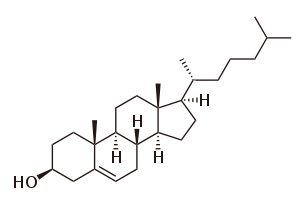Triterpene
Triterpenes are a class of chemical compounds composed of three terpene units with the molecular formula C30H48; they may also be thought of as consisting of six isoprene units. Animals, plants and fungi all create triterpenes, with arguably the most important example being squalene as it forms the basis of almost all steroids.
Triterpene structures
Triterpenes exist in a huge variety of structures with nearly 200 different skeletons known from natural sources or enzymatic reactions.[1] These may be broadly divided according to the number of rings present; although in general pentacyclic structures (5 rings) tend to dominate.
| Number of rings | Examples |
|---|---|
| 0 | Squalene |
| 1 | |
| 2 | Polypodatetraene |
| 3 | Malabaricane |
| 4 | Lanostane |
| 5 | Hopane |
| 6 | Oleanane |
Triterpenoids

By definition triterpenes are hydrocarbons and possess no heteroatoms, functionalized triterpenes should instead be called triterpenoids; however this distinction is not always adhered to in scientific literature, with the two terms often being used interchangeably. Triterpenoids possess a rich chemistry and pharmacology (e.g. Cholesterol) with several pentacyclic motiefs; particularly lupane, oleanane and ursane showing promise as anti-cancer agents.[2][3]
Steroids
Steroids feature a cucurbitane core, although in practice they are biosynthesised from either lanosterol (animals and fungi) or cycloartenol (plants) via the cyclization of squalene. Steroids have two principal biological functions, being either key components of cell membranes or signaling molecules that activate steroid hormone receptors. Important sub-classes include sterols and cucurbitacins.
Triterpenoid saponins
Triterpenoid saponins are triterpenes which belong to the saponin group of compounds, making them triterpenoid glycosides. They are produced by plants as part of their self-defense mechanism[4] with important sub-classes including ginsenosides,[5] eleutherosides.
See also
References
- ↑ Xu, Ran; Fazio, Gia C.; Matsuda, Seiichi P.T. (February 2004). "On the origins of triterpenoid skeletal diversity". Phytochemistry. 65 (3): 261–291. doi:10.1016/j.phytochem.2003.11.014.
- ↑ Laszczyk, Melanie (2009). "Pentacyclic Triterpenes of the Lupane, Oleanane and Ursane Group as Tools in Cancer Therapy". Planta Medica. 75 (15): 1549–60. doi:10.1055/s-0029-1186102. PMID 19742422.
- ↑ Liu, Jie (December 1995). "Pharmacology of oleanolic acid and ursolic acid". Journal of Ethnopharmacology. 49 (2): 57–68. doi:10.1016/0378-8741(95)90032-2. PMID 8847885.
- ↑ Augustin, Jörg M.; Kuzina, Vera; Andersen, Sven B.; Bak, Søren (April 2011). "Molecular activities, biosynthesis and evolution of triterpenoid saponins". Phytochemistry. 72 (6): 435–457. doi:10.1016/j.phytochem.2011.01.015.
- ↑ Attele, Anoja S; Wu, Ji An; Yuan, Chun-Su (December 1999). "Ginseng pharmacology". Biochemical Pharmacology. 58 (11): 1685–1693. doi:10.1016/S0006-2952(99)00212-9.
